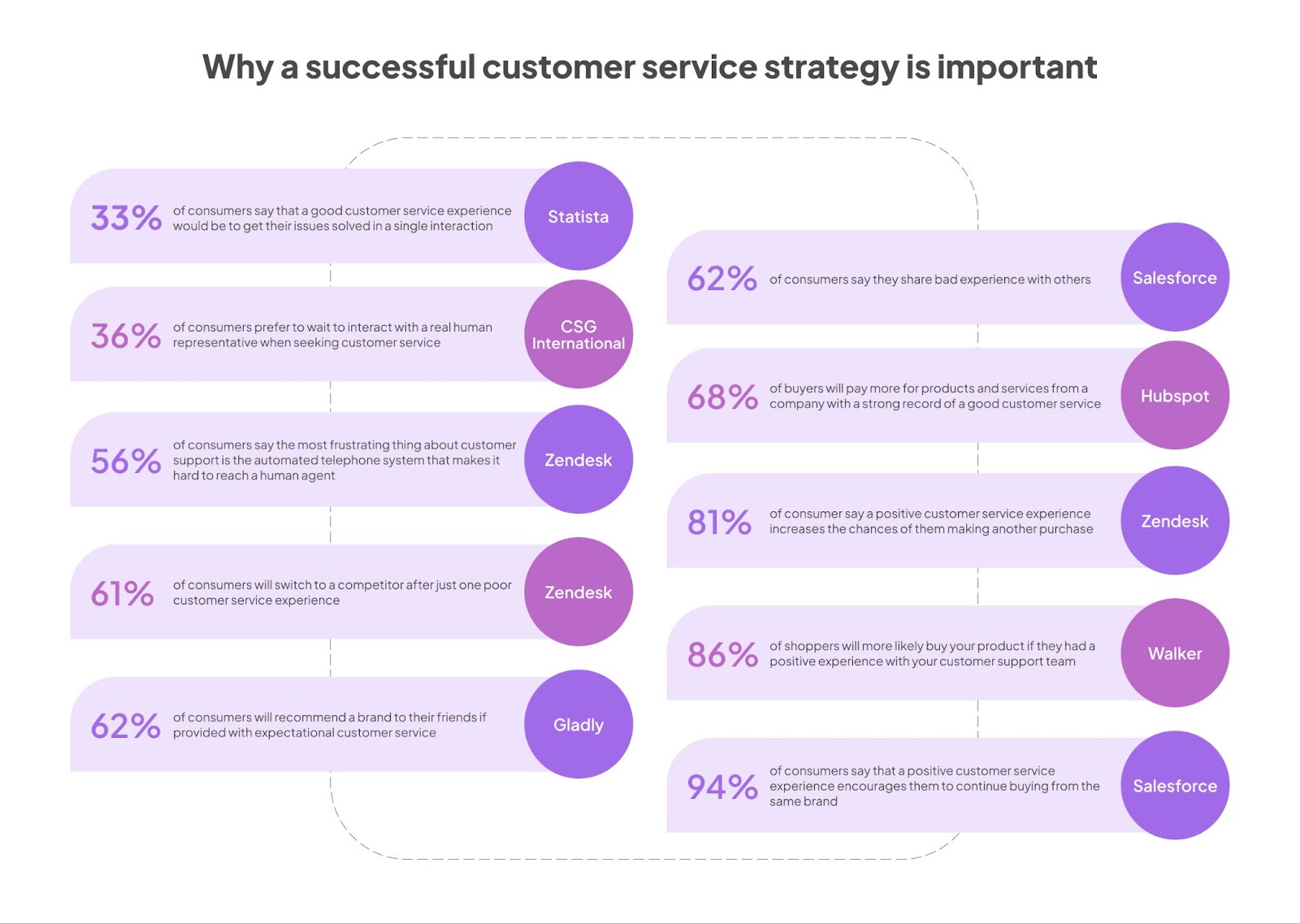How to Choose the Right Offshore Partner for 24/7 Customer Support
%201%20(2).png)
How to choose the right offshore partner for 24/7 customer support
Today’s consumers expect fast, consistent, and helpful support - no matter the time or channel. In fact, 57% expect the same response time at night and on weekends as they do during business hours1. And they’re willing to pay for it - 68% of customers say they’d spend more with companies that offer better service2.
For scaling businesses, that creates a dilemma: How do you meet these rising expectations without exhausting your local team or blowing out your budget?
That’s where partnering with an offshore company comes in - enabling 24/7 coverage through trained support teams who work while your core team rests. But not all providers are built the same. The wrong partner can result in delayed responses, poor service quality, or customer churn. The right one? They’ll act as a true extension of your brand - aligned, capable, and consistent.
In this guide, we walk you through how to evaluate offshore outsourcing partners for customer support, avoid common pitfalls, and build a support function that keeps your customers coming back.
What is customer support outsourcing?
Customer support outsourcing is when a business partners with an external company (often located offshore) to handle customer service functions such as live chat, email, phone support, or social media queries. These teams act as an extension of your internal operations, helping you manage high volumes of enquiries, extend coverage hours, and maintain service quality without the overhead of hiring in-house.
Outsourcing providers typically offer:
- Dedicated agents trained on your product or service
- Multichannel support (chat, voice, email, social, etc.)
- Custom SLAs to maintain performance standards
- Scalable solutions to flex with your business needs
Offshore customer support outsourcing specifically refers to working with teams in different geographic regions (like the Philippines, India, or Sri Lanka) to take advantage of time zone differences, cost efficiencies, and global talent. Working with the right offshore company gives businesses access to trained talent, scalable operations, and round-the-clock service without compromising quality.
Why more businesses are turning to offshore customer support
As customer expectations rise and global markets expand, businesses are under pressure to provide always-on support - without exhausting their local teams or inflating operational costs. Offshore customer support outsourcing has become a strategic resourcing solution, not just a financial one.
The benefits go far beyond cost savings:
1. Timezone coverage for global responsiveness
One of the biggest advantages is timezone coverage. Offshore teams enable businesses to provide real-time support across different regions - whether that’s helping a US-based SaaS customer reset their login at midnight, or resolving an order issue for an Australian shopper browsing after hours. With agents available when your customers are active, support becomes a seamless extension of the customer experience.
2. Faster response times during peak periods
Faster response times are another key benefit. When customer queries pile up during peak hours, wait times can quickly spiral. Offshore support teams can alleviate that pressure, giving eCommerce businesses the ability to handle returns, shipping updates, and payment issues on demand - even during major sale events when volume spikes.
3. Improved customer satisfaction and retention
Customer satisfaction and retention also improve when help is available the moment it’s needed. For industries like banking or FinTech, where clients expect secure, timely responses to sensitive queries, offshore agents trained in data security protocols can provide responsive service while maintaining compliance, regardless of when the query comes in.
4. Flexible, scalable support without long lead times
The flexibility to scale is another reason businesses turn to offshore partners. Startups launching a new product, for example, can quickly expand their support team offshore to accommodate a growing user base, without the long lead times or high overheads that come with expanding locally.
5. Less pressure on your in-house team
Finally, offshore support reduces the load on your local team. Instead of asking staff to cover late-night shifts or weekend rosters, businesses can rely on offshore agents to pick up after-hours tickets. This approach helps prevent burnout, improves team morale, and keeps internal resources focused on strategic work, not support backlogs.
6. Increased sales and fewer drop-offs
When help is available instantly, customers are less likely to abandon purchases. For ecommerce companies, resolving login errors or payment issues at the moment can directly increase conversion rates and reduce cart abandonment.
7. Greater brand trust and visibility
Providing consistent, reliable support around the clock helps position your business as dependable and customer-focused. It also increases the likelihood of positive reviews and word-of-mouth referrals, especially in highly competitive industries.

What to look for in an offshore customer support partner
Not all offshore outsourcing partners are equipped to deliver high-quality, 24/7 customer support. Beyond headcount and hourly rates, the right partner should feel like a natural extension of your team - aligned on culture, quality, and outcomes.
Here’s a checklist to help you assess whether a provider is set up to support your goals and your customers:
- Timezone alignment that matches your support needs
Can they provide agents who work the hours your customers need? Look for teams with full overnight coverage or staggered shifts that complement your local support - especially for global customer bases or late-night service windows.
- Strong English fluency and tone adaptability
Are their support staff fluent in English (or the languages your customers use)? More importantly, can they adjust their tone and communication style to reflect your brand, whether it's friendly and conversational or formal and professional?
- Cultural compatibility and customer understanding
A great offshore partner understands more than just your product - they understand your audience. For example, teams in the Philippines are often chosen for their high English proficiency and cultural alignment with international markets. The right partner should be able to mirror your internal team’s service approach and customer expectations.
- Proven experience and service-level guarantees
Does the offshore company have a track record of delivering consistent, high-quality customer support across time zones and channels? Ask about their client base, available case studies, and whether they offer SLAs that cover metrics like first-response time, resolution speed, or CSAT benchmarks.
- Access to advanced technology and support infrastructure
Many offshore providers offer customer service platforms, ticketing systems, and automation tools that smaller businesses might not otherwise afford. The right partner should be equipped with the tech to enable quick responses, manage multi-channel interactions, and reduce wait times, without adding complexity on your end.
- Robust training and onboarding processes
How do they get their agents up to speed on your business? Look for providers who offer structured onboarding, detailed knowledge transfer, and ongoing training. They should be able to plug into your systems and workflows with minimal friction.
- Reliable communication and escalation protocols
How do they handle daily updates, escalations, and cross-team collaboration? Clear internal workflows (including shift handovers and live communication tools) are essential to maintaining service continuity across time zones.
- Commitment to data security and compliance
Especially in industries like finance, healthcare, and eCommerce, security matters. Ensure your partner follows international compliance standards (like PCI DSS or ISO 27001) and has clear protocols for managing sensitive customer data.

Avoiding common pitfalls when outsourcing customer support
Outsourcing customer support can unlock major advantages, but only if it’s approached with the right mindset and preparation. Even experienced operators can run into issues that impact performance, customer experience, and brand perception.
Here are some common pitfalls to avoid:
- Choosing based on cost alone
While offshore support is typically more affordable, the lowest-cost option often comes with trade-offs - like poor response quality, higher churn, or inconsistent service. Aim for value and alignment, not just savings.
- Underestimating onboarding and training needs
No matter how skilled your outsourced agents are, they still need time to learn your systems, processes, tone of voice, and product specifics. Skipping structured onboarding or ongoing coaching often leads to disconnects in customer experience.
- Overlooking cultural alignment and communication style
Cultural fit plays a bigger role than many expect. If agents don’t understand your customers’ expectations or communicate in a way that feels out of sync, it can erode trust and frustrate users, even if the technical issue is resolved.
- Failing to set clear KPIs and feedback loops
Without defined metrics and regular performance reviews, you won’t know what’s working or where to course-correct. Quality offshore partnerships require transparency, shared goals, and ongoing optimisation.
In fact, one of the biggest mistakes we see businesses make is assuming that offshore support is a plug-and-play solution - something we unpack in detail in our blog (If you're planning to outsource for the first time, that’s a must-read before you start).
Read more: The biggest mistake businesses make when hiring offshore
How to get it right: A simple 5-step framework
If you're outsourcing customer support for the first time or reassessing your current setup, this five-step framework can help you get the most out of your investment.
- Define what success looks like
Start by identifying the outcomes you want to achieve. Are you aiming to reduce response times, improve CSAT, scale during peak periods, or cover specific time zones? Your goals will shape the partner you choose.
- Map your support coverage requirements
Consider your busiest hours, customer locations, and current team availability. Do you need full 24/7 support or targeted after-hours coverage? This will help determine shift patterns and staffing needs.
- Evaluate potential partners against your needs
Use the checklist above to assess each provider. Look beyond generic capabilities - focus on whether they can meet your specific requirements in terms of quality, training, tech, and time zone support.
- Start small, then scale with confidence
A pilot phase allows you to test the setup, refine workflows, and gather data before rolling out fully. Many businesses start with 2–3 agents to build momentum and validate fit.
- Continuously review and optimise
Outsourcing is not set-and-forget. Monitor key metrics, gather customer feedback, and work with your partner to identify areas for improvement, from knowledge gaps to process efficiencies.
The next steps in offshore support
As customer expectations rise and budgets tighten, forward-thinking businesses are combining offshore support with AI-powered tools to drive even greater efficiency. From chatbots handling FAQs to AI-assisted routing and insights, this hybrid model allows businesses to scale support without scaling costs.
To explore how this works in practice, read our blog: AI and outsourcing: The smartest way to cut operational costs in a tough economy
The bottom line? With the right offshore company and a modern support model, you can deliver fast, high-quality, round-the-clock support that doesn’t just meet expectations - it exceeds them.


